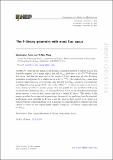| dc.contributor.author | Taylor, Washington | |
| dc.contributor.author | Wang, Yinan | |
| dc.date.accessioned | 2016-06-24T17:31:53Z | |
| dc.date.available | 2016-06-24T17:31:53Z | |
| dc.date.issued | 2015-12 | |
| dc.date.submitted | 2015-12 | |
| dc.identifier.issn | 1029-8479 | |
| dc.identifier.uri | http://hdl.handle.net/1721.1/103328 | |
| dc.description.abstract | Applying the Ashok-Denef-Douglas estimation method to elliptic Calabi-Yau fourfolds suggests that a single elliptic fourfold M[subscript max] gives rise to O(10[superscript 272,000]) F-theory flux vacua, and that the sum total of the numbers of flux vacua from all other F-theory geometries is suppressed by a relative factor of O(10[superscript −3000]). The fourfold M[subscript max] arises from a generic elliptic fibration over a specific toric threefold base B max, and gives a geometrically non-Higgsable gauge group of E [subscript 8] [superscript 9] × F [subscript 4] [superscript 8] × (G [subscript 2] × SU(2))[superscript 16], of which we expect some factors to be broken by G-flux to smaller groups. It is not possible to tune an SU(5) GUT group on any further divisors in M[subscript max], or even an SU(2) or SU(3), so the standard model gauge group appears to arise in this context only from a broken E 8 factor. The results of this paper can either be interpreted as providing a framework for predicting how the standard model arises most naturally in F-theory and the types of dark matter to be found in a typical F-theory compactification, or as a challenge to string theorists to explain why other choices of vacua are not exponentially unlikely compared to F-theory compactifications on M[subscript max]. | en_US |
| dc.description.sponsorship | United States. Department of Energy (contract #DE-SC00012567) | en_US |
| dc.publisher | Springer Berlin Heidelberg | en_US |
| dc.relation.isversionof | http://dx.doi.org/10.1007/JHEP12(2015)164 | en_US |
| dc.rights | Creative Commons Attribution | en_US |
| dc.rights.uri | http://creativecommons.org/licenses/by/4.0/ | en_US |
| dc.source | Springer Berlin Heidelberg | en_US |
| dc.title | The F-theory geometry with most flux vacua | en_US |
| dc.type | Article | en_US |
| dc.identifier.citation | Taylor, Washington, and Yi-Nan Wang. “The F-Theory Geometry with Most Flux Vacua.” Journal of High Energy Physics 2015.12 (2015): n. pag. | en_US |
| dc.contributor.department | Massachusetts Institute of Technology. Center for Theoretical Physics | en_US |
| dc.contributor.department | Massachusetts Institute of Technology. Department of Physics | en_US |
| dc.contributor.mitauthor | Taylor, Washington | en_US |
| dc.contributor.mitauthor | Wang, Yinan | en_US |
| dc.relation.journal | Journal of High Energy Physics | en_US |
| dc.eprint.version | Final published version | en_US |
| dc.type.uri | http://purl.org/eprint/type/JournalArticle | en_US |
| eprint.status | http://purl.org/eprint/status/PeerReviewed | en_US |
| dc.date.updated | 2016-05-23T09:37:39Z | |
| dc.language.rfc3066 | en | |
| dc.rights.holder | The Author(s) | |
| dspace.orderedauthors | Taylor, Washington; Wang, Yi-Nan | en_US |
| dspace.embargo.terms | N | en_US |
| dc.identifier.orcid | https://orcid.org/0000-0001-8566-6706 | |
| dc.identifier.orcid | https://orcid.org/0000-0001-7418-1519 | |
| mit.license | PUBLISHER_CC | en_US |
